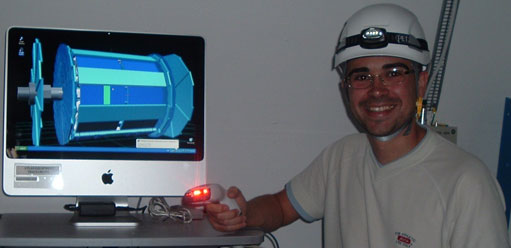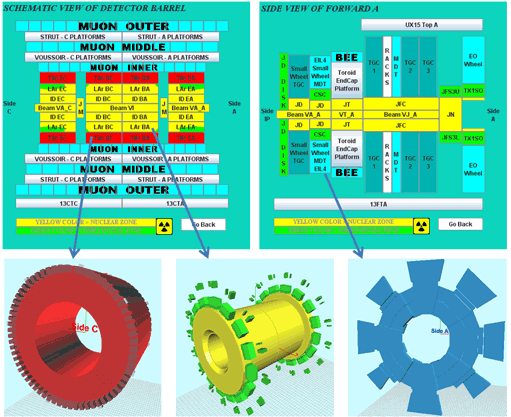
ATLAS e-News
23 February 2011
What goes down might come up!
9 February 2009

Jorge Molina-Perez shows off the software and tagging device
As the ATLAS detector gets closer to see proton collisions, the safety systems designed to measure the radioactivity levels of every piece of equipment that enters the ATLAS cavern need to be very accurate.
For this purpose, the ATLAS Equipment Databases team, formed by Jorge Molina-Perez, Luiz Evora, and Kathy Pommes; have developed a traceability system i.e. the ATLAS Equipment Traceability, to guarantee the radiation safety of all equipment that come out and go into the ATLAS cavern during the operation, maintenance, and dismantling periods.
The constant rotation of equipment down in the pit, due to the constant need for repair or replacement of the multiple sub-detector and hardware parts, leads to the need for a good traceability system of all those components.
“The main purpose of the software that we have developed is to ensure the radiological control of all material from the ATLAS Experimental cavern, tracking the entry point and the final destination of every equipment and measuring its radiation dose, keeping at the same time an historical record of them,” says Jorge Molina-Perez, software engineer of the system.
Based on the radiological control procedures at CERN, the traceability system has been designed to closely monitor the radioactivity levels to which the equipments in the cavern are exposed. “The software first sets the radiation background level, so that the equipment radiation dose can be then measured,” explains Jorge.
The system is also easy to use. Once the user registers a new piece, its radiation dose is read and compared with the radiation background level; if the equipment complies with the limit values, the user can move the equipment outside the cavern, otherwise, a radioprotection technician would take control of the equipment.
“At the moment, since collisions at the LHC haven’t started yet, all the equipments down in the cavern are within the radiation background level,” explains Jorge.
The different parts of the ATLAS detector have been classified according to the radioactivity calculation in two zones: “conventional”, and “radioactive”. The parts of the detector considered “radioactive” are the Inner detector, the LAr cryostats, and most of the Shielding because they are the closest to the beam pipe.
To put things easier to the user, the software reproduces a 3D model of the ATLAS detector, allowing an easy selection by the user of the position from where an equipment part is being dismounted, and the selection of the equipment new destination. The position history is stored.
But all the functionalities are not available for all the users of the interface. “The functionalities are available according to the user role in ATLAS, e.g. only the radioprotection technicians or experts can set the radiation background and measure the parts from the radioactive zone,” Jorge explains.

With just a mouse click, the 3D graphical user interface allows to set the origin and the destination of an equipment in the ATLAS detector (click image for larger copy)
A critical point, which seems trivial, but has a crucial role in the success of the system, is the need for a continuous update of the database records. “The database needs a continuous maintenance; if we loose equipment traceability, then the system would not show the proper information,” says Jorge.
The traceability system is operational since September 10th, but the ATLAS Equipment Databases team is still improving the system. “We are in the process of adapting our system to be used by the LHCb detector, and considering also the scenario of equipment transferring between LHC Experiments e.g. cryogenics”. In addition, users allowed to move detector parts will be trained to use this system and methodology.

Cristina JimenezATLAS e-News
|